
Principles of General, Organic, Biological Chemistry
2nd Edition
ISBN: 9780073511191
Author: Janice Gorzynski Smith Dr.
Publisher: McGraw-Hill Education
expand_more
expand_more
format_list_bulleted
Concept explainers
Question
Chapter 5, Problem 5.52UKC
(a)
Interpretation Introduction
Interpretation:
The reaction type as endothermic or exothermic reaction from the graph has to be given.
The given graph is,
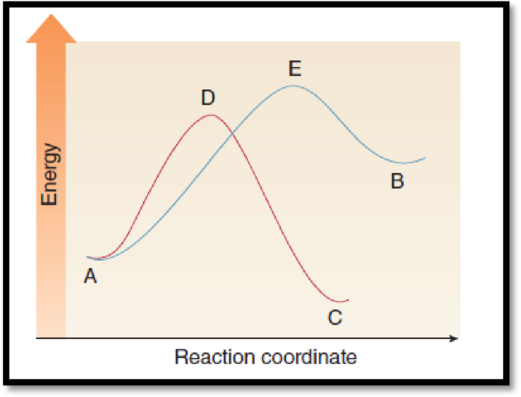
Figure 1
(b)
Interpretation Introduction
Interpretation:
The faster reaction in the graph has to be given.
The given graph is,
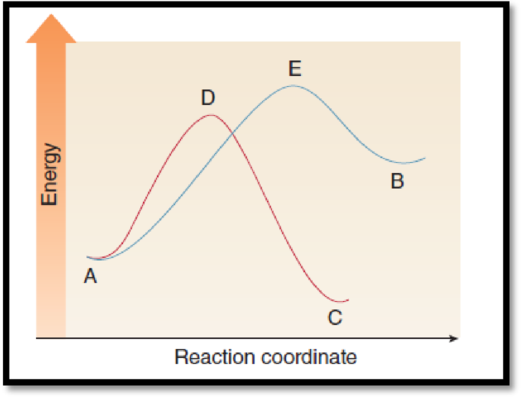
Figure 1
(c)
Interpretation Introduction
Interpretation:
The reaction generates products in lower energy has to be given.
The given graph is,
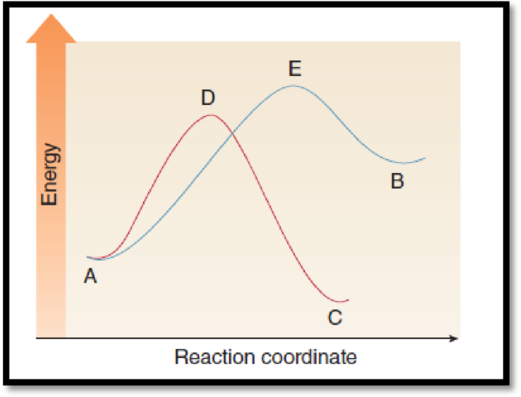
Figure 1
(d)
Interpretation Introduction
Interpretation:
The point on the graph corresponds to the transition state has to be given.
The given graph is,
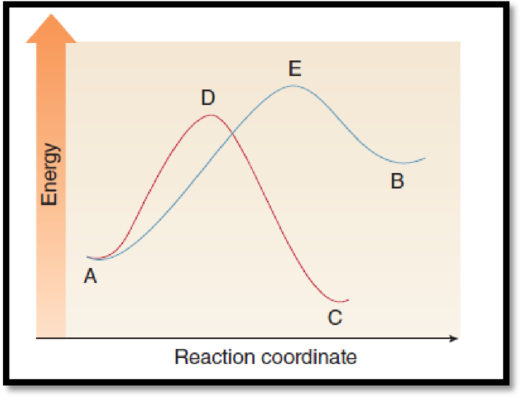
Figure 1
(e)
Interpretation Introduction
Interpretation:
The point corresponds energy of activation has to be given.
The given graph is,
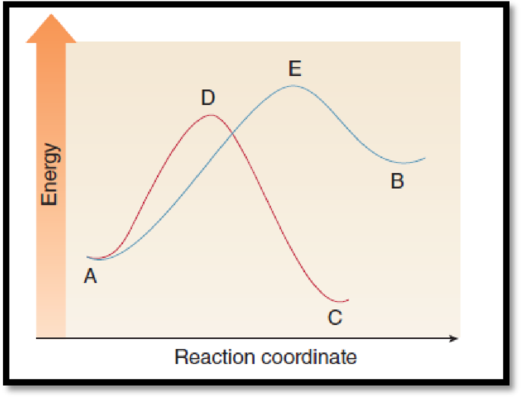
Figure 1
(f)
Interpretation Introduction
Interpretation:
The enthalpy of the reaction has to be given.
The given graph is,
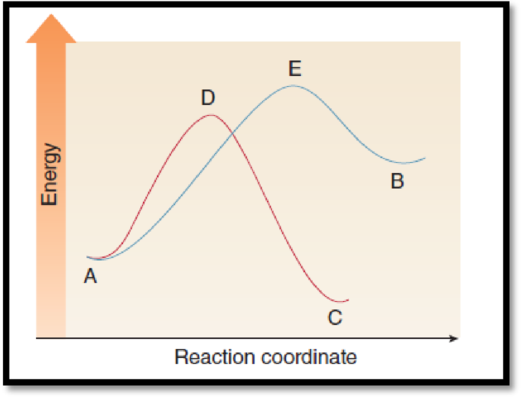
Figure 1
Expert Solution & Answer
Want to see the full answer?
Check out a sample textbook solution
Students have asked these similar questions
Draw the major product of this reaction. Ignore inorganic byproducts.
H3O+
+
O
Write the law of mass action for the following quilibrium 2N2O5(g) --> 4 NO2(g) + O2(g).
State the products (formulas) of the reaction of acetophenone with iodine and NaOH.
Chapter 5 Solutions
Principles of General, Organic, Biological Chemistry
Ch. 5.1 - Use the molecular art to identify the process as a...Ch. 5.1 - Use the molecular at to identify the process as a...Ch. 5.1 - Prob. 5.3PCh. 5.1 - Prob. 5.4PCh. 5.1 - Write a chemical equation from the following...Ch. 5.2 - Prob. 5.6PCh. 5.2 - Prob. 5.7PCh. 5.2 - Prob. 5.8PCh. 5.2 - Prob. 5.9PCh. 5.2 - Prob. 5.10P
Ch. 5.3 - Prob. 5.11PCh. 5.3 - Prob. 5.12PCh. 5.3 - How many molecules are contained in each of the...Ch. 5.3 - Prob. 5.14PCh. 5.4 - Prob. 5.15PCh. 5.4 - Prob. 5.16PCh. 5.4 - Prob. 5.18PCh. 5.4 - Prob. 5.19PCh. 5.5 - Use the balanced equation for the reaction of N2...Ch. 5.5 - Prob. 5.21PCh. 5.6 - Using the balanced equation for fermentation...Ch. 5.6 - Prob. 5.23PCh. 5.6 - Prob. 5.24PCh. 5.6 - Prob. 5.25PCh. 5.7 - Prob. 5.26PCh. 5.7 - Prob. 5.27PCh. 5.7 - Prob. 5.28PCh. 5.7 - Early pacemakers generated an electrical impulse...Ch. 5.8 - Prob. 5.30PCh. 5.8 - Prob. 5.31PCh. 5.8 - Prob. 5.32PCh. 5.8 - Prob. 5.33PCh. 5.9 - Prob. 5.34PCh. 5.9 - Prob. 5.35PCh. 5.9 - Prob. 5.36PCh. 5.10 - Prob. 5.37PCh. 5.10 - In which direction is the equilibrium shifted with...Ch. 5 - Use the molecular art to identify the process as a...Ch. 5 - Prob. 5.40UKCCh. 5 - Prob. 5.41UKCCh. 5 - Prob. 5.42UKCCh. 5 - Prob. 5.43UKCCh. 5 - Prob. 5.44UKCCh. 5 - Prob. 5.45UKCCh. 5 - Spinach, cabbage, and broccoli are excellent...Ch. 5 - Prob. 5.47UKCCh. 5 - Prob. 5.48UKCCh. 5 - Prob. 5.49UKCCh. 5 - Rechargeable nickelcadmium batteries are used in...Ch. 5 - Prob. 5.51UKCCh. 5 - Prob. 5.52UKCCh. 5 - Prob. 5.53UKCCh. 5 - Prob. 5.54UKCCh. 5 - Prob. 5.55APCh. 5 - Prob. 5.56APCh. 5 - Prob. 5.57APCh. 5 - Prob. 5.58APCh. 5 - Prob. 5.59APCh. 5 - Prob. 5.60APCh. 5 - Prob. 5.61APCh. 5 - Prob. 5.62APCh. 5 - Prob. 5.63APCh. 5 - Consider the reaction, 2 NO + 2 CO N2 + 2 CO2....Ch. 5 - Prob. 5.65APCh. 5 - Prob. 5.66APCh. 5 - Prob. 5.67APCh. 5 - Prob. 5.68APCh. 5 - Prob. 5.69APCh. 5 - Prob. 5.70APCh. 5 - Prob. 5.71APCh. 5 - Prob. 5.72APCh. 5 - Prob. 5.73APCh. 5 - Prob. 5.74APCh. 5 - Prob. 5.75APCh. 5 - Prob. 5.76APCh. 5 - Prob. 5.77APCh. 5 - Prob. 5.78APCh. 5 - Prob. 5.79APCh. 5 - Prob. 5.80APCh. 5 - Prob. 5.81APCh. 5 - Prob. 5.82APCh. 5 - Prob. 5.83APCh. 5 - Prob. 5.84APCh. 5 - Prob. 5.85APCh. 5 - Prob. 5.86APCh. 5 - Prob. 5.87APCh. 5 - Prob. 5.88APCh. 5 - Prob. 5.89APCh. 5 - Prob. 5.90APCh. 5 - Prob. 5.91APCh. 5 - Prob. 5.92APCh. 5 - Prob. 5.93APCh. 5 - Prob. 5.94APCh. 5 - Prob. 5.95APCh. 5 - Prob. 5.96APCh. 5 - Prob. 5.97APCh. 5 - Prob. 5.98APCh. 5 - Prob. 5.99APCh. 5 - Prob. 5.100APCh. 5 - Prob. 5.101APCh. 5 - Prob. 5.102APCh. 5 - Prob. 5.103CP
Knowledge Booster
Learn more about
Need a deep-dive on the concept behind this application? Look no further. Learn more about this topic, chemistry and related others by exploring similar questions and additional content below.Similar questions
- Ch. 4- Precipitation Reactions Worksheet Write balanced, complete ionic, and net ionic equations for the following reactions that mav produce precipitates. Use NR to indicate no reaction Ave 1\ +3 =6 Fe + V-2 Na S04 13. Write the balanced equation for the reaction of iron (III) phosphate with sodium sulfate to make iron (III) sulfate and sodium phosphate. 2FePO4 + M, Soy a) If you perform this reaction with 25 grams of iron (III) phosphate and an excess of sodium sulfate, how many grams of iron (III) sulfate can you make? 21 Fe 2 3x 1 Na 3 25g Fe Ingle 150,829 Indes 2 nol 3 1335 349.89 35.90 Ihol & Sanz Fez Bak heck 3x1 50ab) If 18.5 grams of iron (III) sulfate are actually made when you do this reaction, what is your Poy percent yield? 118.5 259-1-100 51.4% (0.74)x100610 335 If you do this reaction with 15 grams of sodium sulfate and get a 65.0% yield, how many grams of sodium phosphate will you make? 10.59 14. Ammonia is produced from the reaction of nitrogen and hydrogen according…arrow_forward== Functional Groups Identifying and drawing hemiacetals and acetals In the drawing area below, create an acetal with 1 isopropoxy group, 1 hydroxyl group, and a total of 10 carbon atoms. Explanation Click and drag to start drawing a structure. Check G +arrow_forwardState the products (formulas) of the reaction of acetophenone with iodine and NaOH.arrow_forward
- Explanation Check Draw the skeletal ("line") structure of 5-hydroxy-4-methyl-2-pentanone. Click and drag to start drawing a structure. Х © 2025 McGraw Hill LLC. All Rights Reserved. Terms of Use | Privacy Cer ☐ : Carrow_forward1. Using a Model set Build a model for the following compound [CH2BrCI]. 2. Build another model of the mirror image of your first molecule. 3. Place the two models next to each other and take a picture which shows the differences between the two models. 4. Determine the absolute stereochemistry R or S for the two models. 5. Write or type a paragraph to Discuss the stereochemical relationship between the two models of CH2BrCl. You must provide an explanation for your conclusions also provide a description for the colors used to represent each atom in the model's images.arrow_forwardWhat parameters are included in the specific rotation calculation of a pure substance based on measurement from a polarimeter? Select one or more: Density of the sample Pathlength of the sample container Enantiomeric excess of the sample Measured rotation of lightarrow_forward
- V Determine whether the following molecule is a hemiacetal, acetal, or neither and select the appropriate box below. Also, highlight the hemiacetal or acetal carbon if there is one. Explanation O CH O Ohemiacetal Oacetal Oneither Check A 2025 McGraw Hill LLC. All Rights Reserved. Terms of Use Privacy Cer 000 Ararrow_forward1. Using Online resources and chemical structures hand draw four different organic compounds (not those already shown in your handout) that are chiral, optically active (a pair of enantiomers will count as one). Pay attention to correct stereochemistry 2. Write or type a short paragraph to Discuss the stereochemical relationship between the four compounds.arrow_forward1. Using a Model set Build a model for the following compound [CHBRIF] 2. Build another model of the mirror image of your first molecule. 3. Place the two models next to each other and take a picture which shows the differences between the two models. 4. Determine the absolute stereochemistry R or S for the two models. 5. Write or type a paragraph to Discuss the stereochemical relationship between the two models of CHBгCIF. You must provide an explanation for your conclusions also provide a description for the colors used to representarrow_forward
- The specific rotation of a sample depends upon measured angle of rotation, the density of the sample, and the pathway length of the light. True Falsearrow_forwardConsider the molecule A,B, C and D shown below, (1 x 4) Br NH2 A OH Br 边 H B C D 1. Assign the R/S configuration to each chiral center and identify by circling all the chiral centers. 2. Draw an image for the enantiomer of each of the compounds A, B, C and D.arrow_forwardCould you crystallize one enantiomer of mandelic acid from a racemic mixture (using the typical achiral solvents found in our lab) without preparing a diastereomeric salt? Why or why not? No, because both enantiomers have the same solubility in achiral solvents. than the other. ооо Yes, because one enantiomer has a higher melting point No, because both enantiomers are liquids. Yes, because one enantiomer is more crystalline than the other.arrow_forward
arrow_back_ios
SEE MORE QUESTIONS
arrow_forward_ios
Recommended textbooks for you
 Chemistry for Engineering StudentsChemistryISBN:9781337398909Author:Lawrence S. Brown, Tom HolmePublisher:Cengage Learning
Chemistry for Engineering StudentsChemistryISBN:9781337398909Author:Lawrence S. Brown, Tom HolmePublisher:Cengage Learning Introductory Chemistry: A FoundationChemistryISBN:9781337399425Author:Steven S. Zumdahl, Donald J. DeCostePublisher:Cengage Learning
Introductory Chemistry: A FoundationChemistryISBN:9781337399425Author:Steven S. Zumdahl, Donald J. DeCostePublisher:Cengage Learning Chemistry for Today: General, Organic, and Bioche...ChemistryISBN:9781305960060Author:Spencer L. Seager, Michael R. Slabaugh, Maren S. HansenPublisher:Cengage Learning
Chemistry for Today: General, Organic, and Bioche...ChemistryISBN:9781305960060Author:Spencer L. Seager, Michael R. Slabaugh, Maren S. HansenPublisher:Cengage Learning- Chemistry: Matter and ChangeChemistryISBN:9780078746376Author:Dinah Zike, Laurel Dingrando, Nicholas Hainen, Cheryl WistromPublisher:Glencoe/McGraw-Hill School Pub Co
 Chemistry In FocusChemistryISBN:9781305084476Author:Tro, Nivaldo J., Neu, Don.Publisher:Cengage Learning
Chemistry In FocusChemistryISBN:9781305084476Author:Tro, Nivaldo J., Neu, Don.Publisher:Cengage Learning Chemistry for Engineering StudentsChemistryISBN:9781285199023Author:Lawrence S. Brown, Tom HolmePublisher:Cengage Learning
Chemistry for Engineering StudentsChemistryISBN:9781285199023Author:Lawrence S. Brown, Tom HolmePublisher:Cengage Learning

Chemistry for Engineering Students
Chemistry
ISBN:9781337398909
Author:Lawrence S. Brown, Tom Holme
Publisher:Cengage Learning

Introductory Chemistry: A Foundation
Chemistry
ISBN:9781337399425
Author:Steven S. Zumdahl, Donald J. DeCoste
Publisher:Cengage Learning

Chemistry for Today: General, Organic, and Bioche...
Chemistry
ISBN:9781305960060
Author:Spencer L. Seager, Michael R. Slabaugh, Maren S. Hansen
Publisher:Cengage Learning

Chemistry: Matter and Change
Chemistry
ISBN:9780078746376
Author:Dinah Zike, Laurel Dingrando, Nicholas Hainen, Cheryl Wistrom
Publisher:Glencoe/McGraw-Hill School Pub Co

Chemistry In Focus
Chemistry
ISBN:9781305084476
Author:Tro, Nivaldo J., Neu, Don.
Publisher:Cengage Learning

Chemistry for Engineering Students
Chemistry
ISBN:9781285199023
Author:Lawrence S. Brown, Tom Holme
Publisher:Cengage Learning